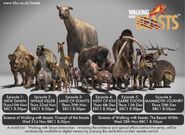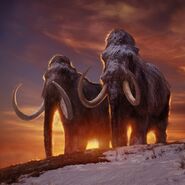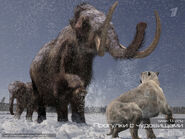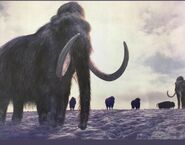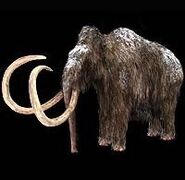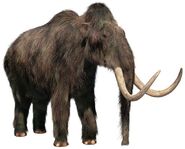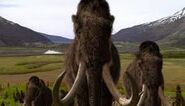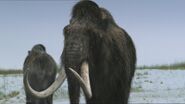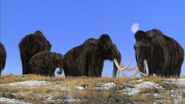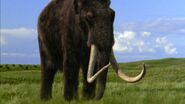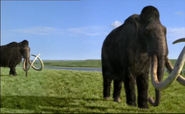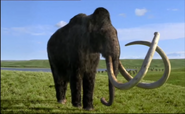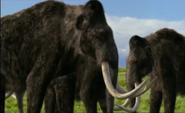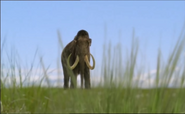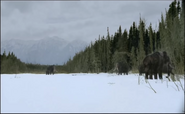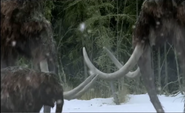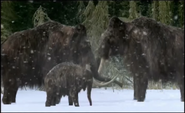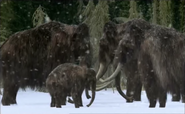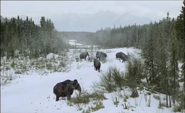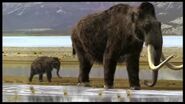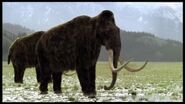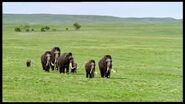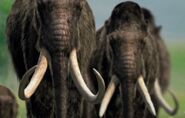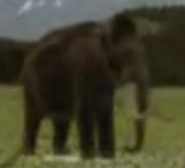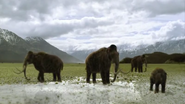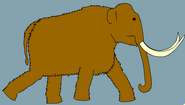The woolly mammoth was a species of mammoth (a group of prehistoric proboscidean) that lived from the late Pleistocene to the mid-late Holocene in the northern hemisphere, mostly in what is now North America and Eurasia.
Facts[]
It is one of, if not, the most famous prehistoric mammals and animals as a whole, possible next to or just as famous as the infamous T. rex. Woolly mammoths had a number of adaptations to the cold, most famously the thick layer of shaggy hair, up to 1 meter in length with a fine
under wool, for which the Woolly mammoth is named. The coats probably molted in summer to cool off, otherwise the Woolly mammoth would overheat and die. They also had far smaller ears than modern elephants; the largest Woolly Mammoth ear found so far was only 30 cm (12 in) long, compared to 180 cm (71 in) for an African elephant. Other characteristic features included a high, peaked head that appears knob-like in many cave paintings and a high shoulder hump resulting from long spines on the neck vertebrae that probably carried fat deposits.
These creatures could have weighed up to eleven or twelve tons. They also needed plains and grasslands and they had to feed sixteen hours a day. Woolly mammoths could also make a grumbling sound with their stomachs, and they used that to communicate with their herd mates, even if they are dead, they try. If their heads were held low and their ears close to their heads, it could mean that they were sick. If you saw even two adult mammoths that looked similar to each other they were probably females from the same herd. They were more social than the males were and had much smaller tusks than the males. If a member of the herd was injured or died, at least one other member would stay behind to comfort their injured companion.
Another feature at times found in cave paintings was confirmed by the discovery of the mummified remains of a baby mammoth. Unlike the trunk lobes of living elephants, Dima's upper lip at the tip of the trunk had a broad lobe feature, while the lower lip had a broad, squarish flap. It is once believed that they lived underground, giving its name, which means "earth mole". The Woolly mammoth was occasionally hunted by Palaeolithic hunters, who also painted it on the walls of caves, engraved its likeness in bony and ivory and made statuettes of it.
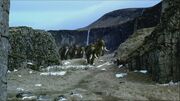
A herd of woolly mammoths. (The Survivors)
Like other mammoth (and similar to elephants), Woolly Mammoths lived in herds led by a matriarch. She could have been 50 or 60 years of age and it was her experience that insured the survival of the herd when the going got tough, and she maintained cohesiveness in the herd. They stopped when she stopped, they slept when she slept, and they fed and drank when she did. However, Woolly Mammoths and other Mammoths were surprisingly more gregarious in their social lifestyles than elephants and (due to preferring life in plains and tundras rather than savannas and jungles) more often lived and traveled in large herds of hundreds to even thousands of animals.
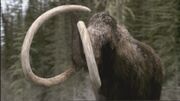
A male Woolly mammoth ready to mate. (Mammoth Journey)
If there was a big bull mammoth near a herd, they could be in musth, which means they were ready to mate. When the males were in that state, they had four times the amount of testosterone they normally had and they were looking for a female to mate with. Males can be really irritable and aggressive and a massive herd of mammoths is such an enchanting sites – there were mothers, grandmas and calves, there were aunties, there were sisters…and they all thrived on their grassland diet, which was so rich, so diverse. Grasses and mosses and all sorts of things.
In addition, mammoths also needed to eat a lot of vegetation. Sometimes, they had to have 180–200 kg of grass, twice a man’s weight in food, every single day. Just like modern day elephants, mammoths seem to have had a strong bond between members of the herd. And that’s what the matriarch did. Whenever there was trouble, she came in to help. Mammoths evolved from hairless ancestors in Africa and have become living fortresses against the cold. (Also, mammoths had small ears and short tails to prevent them from losing too much heat.) Insects were a source of irritation for these animals and the mud Mammoths spray on their head prevented the insects from biting. An important difference between mammoths and most other elephants was the blubber, reaching 10 cm (4 inches) thick.
Until recently it was generally assumed that the last woolly mammoths vanished from Europe and Southern Siberia about 10,000 BC, but new findings show that some were still present there about 1,700 BC. When the ice age retreats, mammoth populations decreased dramatically. Though mammoth populations got smaller because of climate change, it was over-hunting by early humans that drove them to extinction.
In the series[]
Walking with Beasts[]
Mammoth Journey[]
A herd of woolly mammoths were traveling over a frozen lake. One of them broke through the ice and got stuck. The rest of the herd went to her and comforted her for over a day. The herd then had to leave to escape the coming Ice Age winter.
In July the herd is seen eating on a grassland where the North Sea is today. Whilst the females feed, the males mate. In early Autumn, the herd is still on the northern plains, even though most of their food is underneath the snow. They eventually left to migrate further south where the severe winter weather was milder.
The herd traveled through Belgium and beyond. The youngest of the herd was struggling to keep up with the herd but his mother stayed with him. They were also stalked by a cave lion but due to his mother's size, the calf was safe. The rest of the herd joined hundreds of other mammoth herds is the migration to the south. They eventually reached their destination. Then, the mother and calf who were previously left behind caught up and the herd renewed their bond with the pair.
In May, the herd was feeding on the vegetation in the south. The herd was joined by a new arrival, a female calf. The insects were biting so the mammoths sprayed mud on themselves to stop the insects from biting - or perhaps they were doing it for the fun of it.
The herd trekked back north but they went into dangerous ground - Neanderthal territory. During the night, the herd was attacked by a group of Neanderthals. Two mammoths were pushed off a cliff and were killed. After the attack, the rest of the herd arrived at the northern plains however - as the matriarch was killed - her sister took over.
Eventually the herd arrived back at their summer feeding ground, just as the Cro-Magnon humans, also seen through this episode did. While the mammoths began to graze, one of the people was carving a mammoth statuette from ivory - and in the next scene the carving was old and located in a museum along various fossils that included a woolly mammoth...
Walking with Cavemen[]
The Survivors[]
A group of Neanderthals were searching a canyon for food but instead came across a herd of woolly mammoths. The group climbed the canyon and prepared to kill them by pushing a boulder off a cliff. However, one of the Neanderthals coughed and spooked the herd. As the herd fled, the Neanderthals pushed the boulder off the cliff and it hit a mammoth's back. The mammoth was paralyzed and died of its injuries.
Gallery[]
Promotional Images[]
Screenshots[]
Miscellaneous[]
|
African Elephant • Deinotherium • Moeritherium • Palaeomastodon • Woolly mammoth |
|



